old west
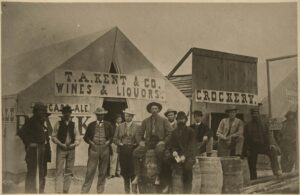 With the Westward migration in the United States, came the cowboys, and with them came the “Old West Saloons,” so that those cowboys wound have a place to wind down after a hard day’s work. We have all heard of the “Old West Cowboys” and while they were a picture of the west, it was the movies that brought them to life for most of us today. As the people moved west, many of the men came on their own at first. That brought the saloon keepers to see if they could make a buck on these men who were hungry for a little socialization. Saloons were common in almost all cities, and a few areas also had Mexican-style cantinas.
With the Westward migration in the United States, came the cowboys, and with them came the “Old West Saloons,” so that those cowboys wound have a place to wind down after a hard day’s work. We have all heard of the “Old West Cowboys” and while they were a picture of the west, it was the movies that brought them to life for most of us today. As the people moved west, many of the men came on their own at first. That brought the saloon keepers to see if they could make a buck on these men who were hungry for a little socialization. Saloons were common in almost all cities, and a few areas also had Mexican-style cantinas.
When we think of the “Old West Saloons,” we usually picture the same style. “A common wooden front with a wooden boardwalk. There were always a few hitching posts to tie a horse. Often a water source would be located close by for horses to drink. The front doors always consisted of two swinging doors that would brush up against a cowboy as he walked into the main bar area. The bar itself was very long to accommodate many standing customers. The floor area consisted of wooden tables and chairs.”
There were usually a group of men at the bar, and some at the tables playing a friendly game of poker…at least it was friendly until someone thought they were getting cheated. You put a few drinks in a guy, add to it the fact that he is losing the poker game, and it a recipe for a fight. That was how most of the violence in the towns got started…right there in the saloon and then, at times it moved out into the roadway.
We all think of the first saloons in the typical way of the movies, but that really wasn’t the case. “The first 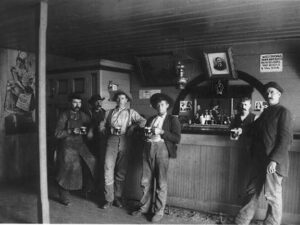 saloons were mostly tents or square wooden structures with tent material thrown over the top. The material was enough to keep the rain off the heads of their customers. The floors were not made of wood. Tent saloons never had floors of any type. If it rained, the floors were muddy, and if it was dry, they were dusty. The only thing the early saloon offered was whiskey and a place to sit and rest.”
saloons were mostly tents or square wooden structures with tent material thrown over the top. The material was enough to keep the rain off the heads of their customers. The floors were not made of wood. Tent saloons never had floors of any type. If it rained, the floors were muddy, and if it was dry, they were dusty. The only thing the early saloon offered was whiskey and a place to sit and rest.”
The first whiskey ever served in a saloon was not the fine whiskey that we all think of. In fact, New Yorkers or those from Chicago would most likely cringe at the taste of the whiskey of the Old West. Whiskey in those days was “raw and made right in the camp or town. The simple ingredients included raw alcohol, sugar burnt, and a little pouch chewing tobacco. Whiskey with terrible names like ‘Coffin Varnish,’ ‘Tarantula Juice,’ ‘Red Eye,’ and others was common among the early saloons.” Later, when the trading with the Indians, the word “Firewater” was used to describe Whiskey. It got that name because they demonstrated its potency by pouring it over the fire. With a high enough proof, the Whiskey acted like gasoline on the fire. The name stuck, and Firewater it was!! Now, the Whisky of those days was not for the “lightweight” and was not to be sipped. The people of those days expected the patrons to drink it quickly. If they didn’t, they might find themselves “drinking a 5th of Whiskey at gunpoint.” Sipping was considered a weakness, and it was not tolerated!
Everyone thinks people of that era drank a lot of beer, but that was not common. Since pasteurization was not invented yet, the bear was warm, and if you didn’t drink it fast, it would get warmer and go flat. Whiskey kept its taste and potency no matter the temperature. “It was not until the 1880s that Adolphus Busch invented artificial refrigeration and pasteurization methods to the brewing process soon after Budweiser launched as a 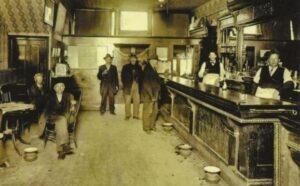 US national brand.”
US national brand.”
The first saloon was opened in the late 1820s in Bent’s Fort, Colorado. “A few little towns already had cantinas, but they did not compare to saloons that would soon spread like wildfire throughout the west. Striking gold was a big indicator that a saloon would pop up in that town. In 1848, Santa Barbara, California, only had one cantina. Yet after the discovery of gold, the town soon grew to 30 saloons. Towns like Livingston, Montana, with its 3,000 residents, had no less than 33 saloons. Back in those days, it was easy to open a business. Innovation and growth were on the incline. Saloons were profitable and with a large customer base.”
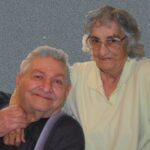
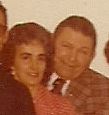 Bill Beadle became my uncle when he married my Aunt Virginia (Byer) Beadle. Uncle Bill was a fun sort of man who always loved to tease the little kids. That made him a favorite of all the kids. You could always tell when Uncle Bill was in a teasing mood, because he would get a twinkle in his eye. I think he was a tickled by the laughter of the kids as they were by his jokes and teasing.
Bill Beadle became my uncle when he married my Aunt Virginia (Byer) Beadle. Uncle Bill was a fun sort of man who always loved to tease the little kids. That made him a favorite of all the kids. You could always tell when Uncle Bill was in a teasing mood, because he would get a twinkle in his eye. I think he was a tickled by the laughter of the kids as they were by his jokes and teasing.
All joking aside, Uncle Bill was raised a hardworking Wyoming man. Born in Worland, he would never live anywhere but Wyoming. He loved everything Wyoming had to offer…hunting and fishing, as well as the great outdoors. Wyoming checked all his boxes, and he was always happy here, and I can see that. While I may not love the cold winter months, Wyoming is a beautiful place and a very nice place to live. A Westerner at heart, his favorite show were Westerns. In fact, he loved all things cowboy, western, and especially the Old West. I suppose it might seem possible that he was living in the wrong era. I think he would have really enjoyed living in the Old West, but we were all born into the era we should be in, and the Old West wasn’t his era.
Uncle Bill led a busy life for most of his life. He worked for years in pipe yards, and later had his own rathole drilling company with his sons, Forrest and Steve. He was an excellent machinist and mechanic. He could fix just about anything. That made him an asset to any employer, as well as a capable businessman.
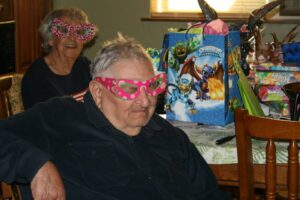 Uncle Bill was an unobtrusive person, who didn’t try to demand attention. That is probably why, at family gatherings, he could be found in a corner of the room. If the kids wanted to hear his jokes, they knew where to find him, and while he didn’t try for their attention, it really pleased him when they sought him out for a few laughs. Always quick with the jokes, the kids were never disappointed when Uncle Bill got going. I’m sure that is why we all missed him when his memory began to go, and he couldn’t really socialize at the family events anymore. The day he started staying home was a sad one for sure. Today would have been Uncle Bill’s 94th birthday. Happy birthday in Heaven, Uncle Bill. We love and miss you very much.
Uncle Bill was an unobtrusive person, who didn’t try to demand attention. That is probably why, at family gatherings, he could be found in a corner of the room. If the kids wanted to hear his jokes, they knew where to find him, and while he didn’t try for their attention, it really pleased him when they sought him out for a few laughs. Always quick with the jokes, the kids were never disappointed when Uncle Bill got going. I’m sure that is why we all missed him when his memory began to go, and he couldn’t really socialize at the family events anymore. The day he started staying home was a sad one for sure. Today would have been Uncle Bill’s 94th birthday. Happy birthday in Heaven, Uncle Bill. We love and miss you very much.
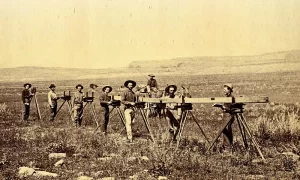 The job of marking out the boundaries of a property, much less an entire nation, while maybe not a complicated job, a big job, nevertheless. The 19th century surveyors were charged with the job of mapping out the entire United States, and to me, that is a huge undertaking. These men were more than just surveyors. These men were the unheralded vanguards of the Old West. They established original geographical boundaries and retraced and identified existing borders in accordance with legal descriptions. It is said that they were part-astronomers, part-geologists, part-engineers, and these mapmakers were also arbitrators when land lines were in dispute. Several wars, and many smaller feuds have been fought and people killed over boundary disputes, and sometimes the surveyor had to be called in to settle the matter.
The job of marking out the boundaries of a property, much less an entire nation, while maybe not a complicated job, a big job, nevertheless. The 19th century surveyors were charged with the job of mapping out the entire United States, and to me, that is a huge undertaking. These men were more than just surveyors. These men were the unheralded vanguards of the Old West. They established original geographical boundaries and retraced and identified existing borders in accordance with legal descriptions. It is said that they were part-astronomers, part-geologists, part-engineers, and these mapmakers were also arbitrators when land lines were in dispute. Several wars, and many smaller feuds have been fought and people killed over boundary disputes, and sometimes the surveyor had to be called in to settle the matter.
Some famous men that we all know started out as surveyors. Men like George Washington, Thomas Jefferson, Abraham Lincoln, Meriwether Lewis, William Clark and Daniel Boone When these men were surveyors, actually risked their lives in the line of duty to map what ultimately became the passes, railroads, towns, dams and other structures that helped form the backbone of the West.
Surveyors were the ones who shaped Western history. Their endurance, sense of adventure, and knowledge of precision tools and mathematical principles became the tools of their trade. In fact, they really became Jocks of all trades. While surveying the many miles of the United States, the had to actually blaze trails, so they had to become woodsman, so they could get through some areas to even begin surveying the borders. They became experts in the science of soil management and crop production. As agronomists they worried that hot weather, combined with dry conditions, can hamper pollination. They had to understand the soil and botany. They had to find their food in the wild, because there weren’t any stores in the rugged, wilderness they were mapping.
It was a hard job, and there were many risks, but these men were strong-willed, and determined…and sometimes their lives were on the line. In 1838, came one of the first incidence of a surveyor being killed. It happened just two years after the Battle of San Jacinto…a battle in which the Texians defeated Mexican General Antonio López de Santa Anna. While surveying on the Guadalupe River north of San Antonio, Indians attacked a survey party and killed nine of the crew, including one surveyor who managed to carve his name, “Beatty,” on a tree before he died. At least seven more survey parties were attacked that spring and summer, from the Rio Frio to the Red Sometimes River.
The surveyors were essential when the railroad was being built. The surveyors were the ones who marked out 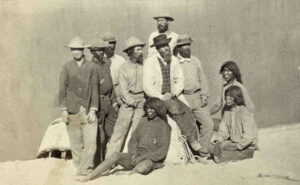 that track lines. They had to make sure they were not overtaking the landowners’ boundaries. The Indians were the main people to fight the surveyors, because they could see more and more of their land being confiscated. What would eventually be good, even for them, was seen as theft to them, and maybe it was, but when we look to the future, it’s easy to see that the land was going be essential to the people of the United States down the road. Nevertheless, the surveyors faced many dangers and really also had to be soldiers, because they were often in a fight for their lives, as they did their work. Surveyors were, and still are, essential to the ever-changing boundry lines in our nation, but that doesn’t make their job an easy one.
that track lines. They had to make sure they were not overtaking the landowners’ boundaries. The Indians were the main people to fight the surveyors, because they could see more and more of their land being confiscated. What would eventually be good, even for them, was seen as theft to them, and maybe it was, but when we look to the future, it’s easy to see that the land was going be essential to the people of the United States down the road. Nevertheless, the surveyors faced many dangers and really also had to be soldiers, because they were often in a fight for their lives, as they did their work. Surveyors were, and still are, essential to the ever-changing boundry lines in our nation, but that doesn’t make their job an easy one.
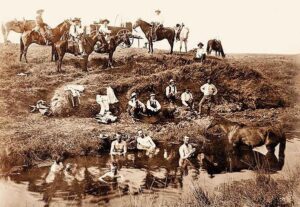
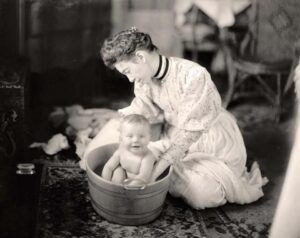 These days, we know that washing our hands and our bodies is important to good health. Of course, washing of hands cleans away dirt, germs, and bacteria, as well as many viruses that cause disease, but in the Old West, there were actually people who thought that bathing could actually make you sick, therefore bathing did not occur on a daily basis in the wild west. I’m sure you can imagine just how stinky things got. I suppose that if two people got very near each other, it would be a competition to see who smelled the worst. The reality is that we have all encountered someone who really needed a bath. Most of us would never tell that person that they stunk, but we might really hope that this wasn’t going to be the norm, or we might have to rethink the friendship.
These days, we know that washing our hands and our bodies is important to good health. Of course, washing of hands cleans away dirt, germs, and bacteria, as well as many viruses that cause disease, but in the Old West, there were actually people who thought that bathing could actually make you sick, therefore bathing did not occur on a daily basis in the wild west. I’m sure you can imagine just how stinky things got. I suppose that if two people got very near each other, it would be a competition to see who smelled the worst. The reality is that we have all encountered someone who really needed a bath. Most of us would never tell that person that they stunk, but we might really hope that this wasn’t going to be the norm, or we might have to rethink the friendship.
Women in the old west “bathed” a little more often than the men, if you could exactly call it that. Mostly any daily bathing would consist of a pitcher of water and a washcloth, with the ritual performed in the bedroom of the home. Men on the cattle trail might take a plunge into a watering hole to get “cleaned up”, and quite often the bathing and the laundry would happen at the same time, meaning that a good portion of the body didn’t really get scrubbed up. Nevertheless, it was a good way to rid yourself of that nasty trail dust accumulated on the trail that day…or maybe the prior several days. This type of bathing might also involve armed guards to keep the Indians away.
To make matters worse, when people did bathe, it might be done in the kitchen in a large tub of water, used by the husband first, the mother second, and the children by ages on down the line. As you can imagine, the water got pretty black by the time the youngest child was bathed. Then the water was finally dumped. That is actually where the term, “don’t throw the baby out with the bath water came from.” Sometimes being the youngest had its perks, and other times not so much. Some people would go to public bathhouses, where they might actually have to pay extra for “clean” water, and the guy after them might end up using their water, if he didn’t want to pay the extra fee.
The fact that bathing was inconvenient, and for some, scary, made people sometimes resort to other methods 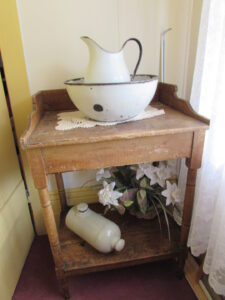
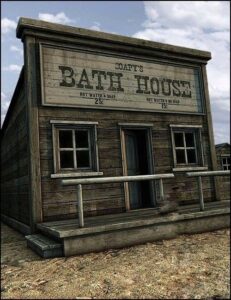 to rid themselves of the stinky odor. After all, lemon verbena wasn’t just a type of perfume. It helped to mask the odor that would come quickly with infrequent bathing. To make matters worse, people lived in primitive surroundings with lice, fleas and bedbugs, and the smell of their own dirty bodies drew flies and mosquitoes. Hopefully, the lemon verbena would help to keep the pests away…but I wouldn’t count on it really. I don’t think it masked the smell that well.
to rid themselves of the stinky odor. After all, lemon verbena wasn’t just a type of perfume. It helped to mask the odor that would come quickly with infrequent bathing. To make matters worse, people lived in primitive surroundings with lice, fleas and bedbugs, and the smell of their own dirty bodies drew flies and mosquitoes. Hopefully, the lemon verbena would help to keep the pests away…but I wouldn’t count on it really. I don’t think it masked the smell that well.
These days, we not only know that bathing is important to keep the stinky smells away, but it’s important to keep sickness away too. Most of us wouldn’t think of going long without bathing, after all, warding off sickness is important, but warding off that smell is vital!!
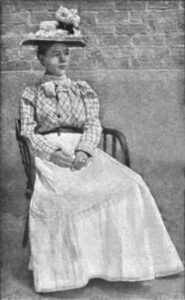
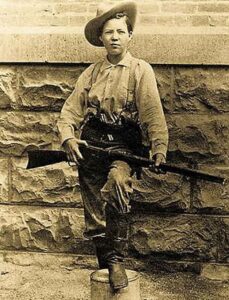 Pearl Hart was born Pearl Taylor in 1871, in the Canadian village of Lindsay, Ontario. Her parents were both religious and affluent, which allowed them to provide their daughter with the best available education. At the age of 16 and a bit of a rebel, she was enrolled in a boarding school where she fell in love with a young man named Hart, who has been variously described as “a rake, drunkard, and/or gambler.” That reputation didn’t deter Pearl and before long, the couple eloped, but Pearl soon discovered that her new husband was abusive and left him to return to her mother.
Pearl Hart was born Pearl Taylor in 1871, in the Canadian village of Lindsay, Ontario. Her parents were both religious and affluent, which allowed them to provide their daughter with the best available education. At the age of 16 and a bit of a rebel, she was enrolled in a boarding school where she fell in love with a young man named Hart, who has been variously described as “a rake, drunkard, and/or gambler.” That reputation didn’t deter Pearl and before long, the couple eloped, but Pearl soon discovered that her new husband was abusive and left him to return to her mother.
One would have thought that she would have learned her lesson and changed her ways before her future life of crime got started, but she chose to become an American Old West outlaw. Pearl Hart gained notoriety just before the turn of the 20th century as a female stagecoach robber. She cut her hair short, dressed in men’s clothing. She actually committed one of the last recorded stagecoach robberies in the United States, and her crime gained notoriety primarily because of her gender. To find out that a woman of that era was brave enough to pull off a stagecoach robbery was very unusual indeed.
Many details of Hart’s life are uncertain, with available reports being varied and often contradictory. It is thoughts that Hart reconciled with and left her husband several times. During their time together they had two children, a boy and a girl, whom Hart sent to her mother who was then living in Ohio. At least her children had a stable home. In 1893, the couple attended the Chicago World’s Fair, where he worked for a time as a midway barker. She in turn developed a fascination with the cowboy lifestyle while watching Buffalo Bill’s Wild West Show. At the end of the World’s Fair, Hart left her husband again on a train bound for Trinidad, Colorado, possibly in the company of a piano player named Dan Bandman.
By early 1898, Hart was in the town of Mammoth, Arizona. Some reports indicate she was working as a cook in a boardinghouse, while others indicate she was operating a tent brothel near the local mine. While doing well for a time, her financial outlook took a downturn after the mine closed. About this time Hart attested to receiving a message asking her to return home to her seriously ill mother. Looking to raise money, Hart and a friend known only as “Joe Boot” worked an old mining claim he owned, but they found no gold in the claim.
It was then that they decided to rob the stagecoach traveling between Globe and Florence, Arizona. On May 30, 1899, at a watering point near Cane Springs Canyon, about 30 miles southeast of Globe, they began their robbery run. Hart had cut her hair short and dressed in men’s clothing. Hart was armed with a .38 revolver while Boot had a Colt .45 revolver. The stagecoach run had not been robbed in several years, so the coach did not have a shotgun messenger. The pair stopped the coach and Boot held a gun on the robbery victims while Hart took $431.20, which would be about $13,500 today, and two firearms from the passengers. After returning $1 to each passenger, she then took the driver’s revolver. It was such an odd gesture. After the robbers made their getaway, the driver unhitched one of the horses, headed to town to alert the sheriff.
Accounts of the next few days vary. According to Hart, the pair took a circuitous route designed to lose anyone who followed while they made their future plans. Others claim the pair became lost and wandered in circles. Regardless, a posse led by Sheriff Truman of Pinal County caught up with the pair on June 5, 1899. Finding both of them asleep, Sheriff Truman reported that Boot surrendered quietly while Hart fought to avoid capture. Hart was eventually caught and after being found guilty, sentenced to five years in prison. She was pardoned 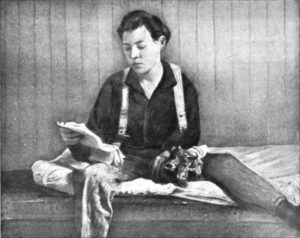
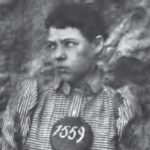 after three years. Some accounts have her returning to Tucson 25 years after her imprisonment to visit the jail cell that once held her. A census taker in 1940 claimed to have discovered Hart living in Arizona under a different name, as she had married again. Pearl Bywater was living a private life with her husband of 50 years, George Calvin “Cal” Bywater. She is acknowledged as the only known female stagecoach robber in Arizona’s history, earning her the nicknames of “Bandit Queen” or “Lady Bandit.”
after three years. Some accounts have her returning to Tucson 25 years after her imprisonment to visit the jail cell that once held her. A census taker in 1940 claimed to have discovered Hart living in Arizona under a different name, as she had married again. Pearl Bywater was living a private life with her husband of 50 years, George Calvin “Cal” Bywater. She is acknowledged as the only known female stagecoach robber in Arizona’s history, earning her the nicknames of “Bandit Queen” or “Lady Bandit.”

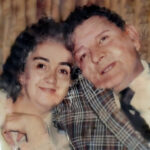 My uncle, Bill Beadle was a unique kind of man. He loved all things cowboy, western, and especially the Old West. I suppose it’s possible that he was rather living in the wrong era. It’s not that God made a mistake and put him in the wrong time, but sometimes our own preferences make us feel like we might have been better suited to a different era. I’m quite sure that his family would have argued that point with him anyway, if he were to suggest that he should have lived in the Old West. Really though, for Uncle Bill, it wasn’t about living in the Old West, it was about loving Wyoming…and he really did.
My uncle, Bill Beadle was a unique kind of man. He loved all things cowboy, western, and especially the Old West. I suppose it’s possible that he was rather living in the wrong era. It’s not that God made a mistake and put him in the wrong time, but sometimes our own preferences make us feel like we might have been better suited to a different era. I’m quite sure that his family would have argued that point with him anyway, if he were to suggest that he should have lived in the Old West. Really though, for Uncle Bill, it wasn’t about living in the Old West, it was about loving Wyoming…and he really did.
He loved all the outdoor activities that were favorites of his. He loved to hunt and fish. He loved spending time with his family in the great outdoors. His sons were his favorite companions…other than my Aunt Virginia, of  course. He was born in Worland, Wyoming, and he always loved Wyoming. This would be the place he wanted most to be.
course. He was born in Worland, Wyoming, and he always loved Wyoming. This would be the place he wanted most to be.
Uncle Bill was always funny and humorous, and I liked visiting with him. When his memory started to go, Uncle Bill could no longer come to the family parties, and so, many of us lost track of him. He struggled to communicate with family, and it simply became easier to just stay home and not try to carry on those conversations. I really miss those times with Uncle Bill. Today would have been Uncle Bill’s 93rd birthday. Happy birthday in Heaven, Uncle Bill. We love and miss you very much.
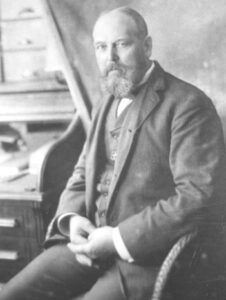
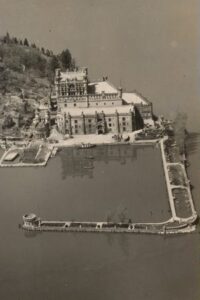 We don’t often think of the United States having castles, but some do exist. Most are not considered true castles, but are rather country houses, follies, or other types of buildings built to give the appearance of a castle. In architecture, a folly is a building constructed primarily for decoration, but suggesting through its appearance some other purpose, or of such extravagant appearance that it transcends the range of usual garden buildings. Castles seem like almost ancient history items to most of us, and when it came to the United States, many people thought of the Old West and homestead type dwellings. Nevertheless, there are a few real castles here in the United States, even if we don’t have royalty here.
We don’t often think of the United States having castles, but some do exist. Most are not considered true castles, but are rather country houses, follies, or other types of buildings built to give the appearance of a castle. In architecture, a folly is a building constructed primarily for decoration, but suggesting through its appearance some other purpose, or of such extravagant appearance that it transcends the range of usual garden buildings. Castles seem like almost ancient history items to most of us, and when it came to the United States, many people thought of the Old West and homestead type dwellings. Nevertheless, there are a few real castles here in the United States, even if we don’t have royalty here.
One such castle is Bannerman Castle in New York. The castle is located on Pollepel Island, about 50 miles north of New York City, on the Hudson River. The castle is in serious disrepair, but the Bannerman Castle Trust, Inc is trying to shore up the buildings so they don’t deteriorate further. The analysis that has been done indicates that 5 out of the 7 buildings on the island could be shored up. The others are too far gone. The castle has a strange history, and I suppose some would debate it’s claim as a true castle. The castle was built by Frank Bannerman VI over a period of 17 years. The island’s buildings were personally designed by Bannerman without professional help from architects, engineers, or contractors. The island has buildings, docks, turrets, garden walls, and a moat in the style of old Scottish castles. That was his passion. He loved Scottish castles and built his castle with a Scottish flare. All of the buildings are elaborately decorated, from biblical quotations cast into all fireplace mantles, to a shield between the towers with a coat of arms, and a wreath of thistle leaves and flowers.
Bannerman’s family immigrated to America in 1854, when he was three. They settled in Brooklyn, New York, where his father established a business selling flags, rope, and other articles acquired at Navy auctions. He was a patriotic man, who joined the union army during the Civil War. At that time young Frank began running the business. He was 13 years old. When the Civil War ended, the US government auctioned off military goods by the ton, mostly to be scrapped for their metal. It was young Frank who saw the importance of these materials, and it was his wise purchases that earned him the moniker “Father of the Army-Navy Store.” He could see that much of what was being sold had a market value higher than scrap. Under the guidance of the younger Bannerman, the Bannerman family became the world’s largest buyer of surplus military equipment. By this time, their storeroom and showroom took up a full block at 501 Broadway. Bannerman made his store into a type of museum/store. It opened to the public in 1905. Of it, the New York Herald said, “No museum in the world exceeds it in the number of exhibits.”
Frank was very prosperous, and it was during a business trip to Ireland that he met his future wife, Helen Boyce. They had three children. At the close of the Spanish American War, Frank Bannerman purchased 90 
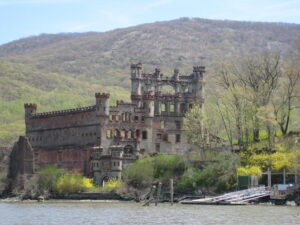 percent of all captured goods in a sealed bid. After that, it became necessary to find a secure place to store their large quantity of very volatile black powder. His son, David saw Pollepel Island, in the Hudson, and Frank Bannerman purchased it in 1900. Following the purchase, the building of the castle began. Today, the island is owned by the state of New York, and at this time visits are prohibited until the buildings can be made safer.
percent of all captured goods in a sealed bid. After that, it became necessary to find a secure place to store their large quantity of very volatile black powder. His son, David saw Pollepel Island, in the Hudson, and Frank Bannerman purchased it in 1900. Following the purchase, the building of the castle began. Today, the island is owned by the state of New York, and at this time visits are prohibited until the buildings can be made safer.
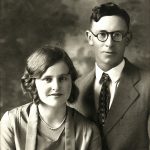
 My husband, Bob Schulenberg’s grandmother, Nettie Knox was not born during the pioneer era, but she did live a life that mirrored that era to a degree. While she was born in the West, in Clydes Park, Montana, she was nevertheless, a kind of pioneer woman. Grandma was born on June 30, 1909 to Orin and Eva (Landis) Noyes, and married Robert Knox on June 14, 1928. She was not born before cars were invented, but sometimes she lived like she was in the Old West. Grandpa was worked on a sheep ranch, and for a time when my mother-in-law, Joann Schulenberg was a little girl of about 3 years, they lived in a sheep wagon. The shepherd needed to be near the sheep, and Grandma was a homemaker, so she went with him. Plus, the sheep wagon was provided to them free of charge, and you don’t turn down a rent free place to live. Of course, that wasn’t where they lived for very long, because even with just the three of them for the first 15 years of her life, living in a sheep wagon would not really be roomy enough.
My husband, Bob Schulenberg’s grandmother, Nettie Knox was not born during the pioneer era, but she did live a life that mirrored that era to a degree. While she was born in the West, in Clydes Park, Montana, she was nevertheless, a kind of pioneer woman. Grandma was born on June 30, 1909 to Orin and Eva (Landis) Noyes, and married Robert Knox on June 14, 1928. She was not born before cars were invented, but sometimes she lived like she was in the Old West. Grandpa was worked on a sheep ranch, and for a time when my mother-in-law, Joann Schulenberg was a little girl of about 3 years, they lived in a sheep wagon. The shepherd needed to be near the sheep, and Grandma was a homemaker, so she went with him. Plus, the sheep wagon was provided to them free of charge, and you don’t turn down a rent free place to live. Of course, that wasn’t where they lived for very long, because even with just the three of them for the first 15 years of her life, living in a sheep wagon would not really be roomy enough.
Grandma loved tradition, Christmas, birthdays, and celebrations in general, but when my daughter, Corrie Petersen was born on her birthday, and she was her first great grandchild, Grandma was ecstatic!! She considered that to be the greatest git ever, and they always had a strong bond. They always celebrated that birthday together, and new pictures were taken every year to see how much they had both changed. Of course, to me it seemed that it was Corrie did the changing. She was the one that was growing up, and Grandma seemed to have a timelessness about her. In fact, it seemed like she had an innocence about her. Maybe it was her love of tradition and celebration, or maybe she was just blessed with good genes. Whatever it was, Grandma just never seemed to get old…to me at least. Maybe that was why Grandma and Corrie could have such a great relationship too. They could both get excited about the same kinds of things.
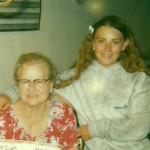
 When I think of what Corrie is working on becoming, and has already become, I know that Grandma Knox would have been so proud of her. Grandma suffered with arthritis and always whiced that the medical community could find a cure for it. While there is no cure yet, maybe there will be someday. Nevertheless, Corrie tries to comfort people, no matter what the disease is that they have. Her job is is give comfort to her patients, and I know that Grandma would have seen that as a great contribution to the world. Today is the 113 anniversary of Grandma’s birth. Happy birthday in Heaven, Grandma. We love and miss you very much.
When I think of what Corrie is working on becoming, and has already become, I know that Grandma Knox would have been so proud of her. Grandma suffered with arthritis and always whiced that the medical community could find a cure for it. While there is no cure yet, maybe there will be someday. Nevertheless, Corrie tries to comfort people, no matter what the disease is that they have. Her job is is give comfort to her patients, and I know that Grandma would have seen that as a great contribution to the world. Today is the 113 anniversary of Grandma’s birth. Happy birthday in Heaven, Grandma. We love and miss you very much.
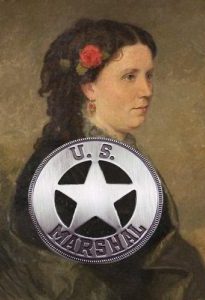 In the days of the Old West, women were considered the “weaker sex” and they were supposed to be cared for and protected by their male counterparts. Most women were fine with that idea, but there were a few, like Annie Oakley and Susan Anderson, who broke the mold. Annie Oakley was an amazing markswoman and Susan Anderson was a doctor. These women weren’t alone in their desire to leave their mark on the world.
In the days of the Old West, women were considered the “weaker sex” and they were supposed to be cared for and protected by their male counterparts. Most women were fine with that idea, but there were a few, like Annie Oakley and Susan Anderson, who broke the mold. Annie Oakley was an amazing markswoman and Susan Anderson was a doctor. These women weren’t alone in their desire to leave their mark on the world.
The world of law enforcement, especially in those days was clearly a man’s world, but in 1891, a woman named F M Miller was commissioned out of the federal court at Paris, Texas as the only female deputy that worked the Indian Territory. Miller was known as a fearless and efficient officer, who had locked up more than a few offenders. She was a “young woman of prepossessing appearance, wears a cowboy hat and is always adorned with a pistol belt full of cartridges and a dangerous looking Colt pistol which she knows how to use.” Apparently, hiring a female deputy wasn’t all that unusual, but the women deputies were known as office deputies, basically a secretary.
Oklahoma has set the pace for something more. United States Marshal C H Thompson, of Guthrie appointed two women as deputies for field work. It was almost unheard of. If a woman choose the vocation of professional thief taker in the most civilized portion of the land would be strange enough, but how strange is it when she chooses field duty on the worst territory in the Union. Criminals in Oklahoma and in Indian Territory, the district where these two girls, S M Burche and Mamie Fossett spent their days, were among the most dangerous anywhere. They were accused of murder, rape, robbery, arson, adultery, bribery, and numerous other crimes. These outlaws initially hid out in Indian Territory, because it was without law enforcement, with the exception of the Indian Nations’ police forces, who had no jurisdiction over the many criminals who had taken flight from other states. The outlaws were ruthless and willing to kill to avoid jailtime. More lives were lost among Federal officers in a year than in all the rest of the nation together. So it would seem that these girls possessed exceptional guts and spunk to willingly undertake such duties.
Burche and Fossett were truly spunky and adventurous women. They had no qualms about invading the newly opened Oklahoma territory. They were young, fairly good-looking, well-educated, fearless, and independent…and they were definitely not Marshal Thompson’s secretaries. When they took the oath of office and assumed their duties it was with distinct understanding that they would serve the Government just as would any other deputy marshal. They were to take the field, serve writs and warrants, and make arrests just as any male deputy might be called on to do. And they did it with great success.
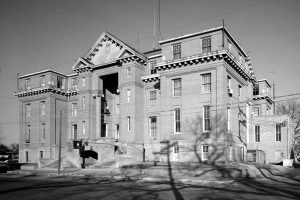
The wildness of the Oklahoma and Indian Territory would soon come to an end when Judge Isaac Parker was appointed to the Western Judicial District of Arkansas, which included Indian Territory. Parker would go on to command about 200 deputy marshals to “clean up” the lawless territory, but that would take years as the deputies struggled to cover the more than 74,000 square miles in their search for hundreds of wanted fugitives. It was not going to be a speedy process. Into this dangerous midst, a number of men made names for themselves. Men such as Heck Thomas, Bass Reeves, Bill Tilghman, Chris Madsen, and dozens of others. More quietly, a few other deputies also made names for themselves. Quietly, because they were women.
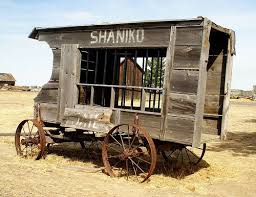 Most people know what the paddy wagon is, and nobody wants to end up in one. An old term for arresting vehicle, the term gets it’s roots from the Irish. Apparently, many of the police officers in early America were of Irish descent. According to Dictionary.com, “Irishman,” 1780, slang, from the pet form of the common Irish proper name Patrick (Irish Padraig). It was in use in black slang by 1946 for any “white person.” Paddy wagon is 1930, perhaps so called because many police officers were Irish. Paddywhack (1881) originally meant “an Irishman.” I suppose that many would look at this slang name for police officer as disrespectful, and they might be right, but no more disrespectful that pig or even cop. Nevertheless, the Paddy Wagon was just a
Most people know what the paddy wagon is, and nobody wants to end up in one. An old term for arresting vehicle, the term gets it’s roots from the Irish. Apparently, many of the police officers in early America were of Irish descent. According to Dictionary.com, “Irishman,” 1780, slang, from the pet form of the common Irish proper name Patrick (Irish Padraig). It was in use in black slang by 1946 for any “white person.” Paddy wagon is 1930, perhaps so called because many police officers were Irish. Paddywhack (1881) originally meant “an Irishman.” I suppose that many would look at this slang name for police officer as disrespectful, and they might be right, but no more disrespectful that pig or even cop. Nevertheless, the Paddy Wagon was just a 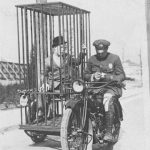 vehicle used to transport prisoners to jail. These days, unless it is a big group being arrested at one time, paddy wagons aren’t used much, but they used to be much more common. I’m sure there were many outlaws who knew the inside of a paddy wagon well…at least the ones who were’t very good at their skill. Those who were good at it usually avoided the paddy wagons.
vehicle used to transport prisoners to jail. These days, unless it is a big group being arrested at one time, paddy wagons aren’t used much, but they used to be much more common. I’m sure there were many outlaws who knew the inside of a paddy wagon well…at least the ones who were’t very good at their skill. Those who were good at it usually avoided the paddy wagons.
Back in the Old West, paddy wagons really were wagons, but then so was every other mode of personal transportation, and many forms of business transportation. With the invention of the motorized vehicle, came a different type of Paddy Wagon too. And with the invention of the motorcycle, came an even more unusual type of Paddy Wagon. I 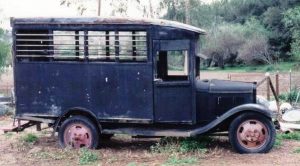 can’t really imagine being taken to jail in a cage attached to a motorcycle, but there were those who were taken that way. This seemed to be common in Los Angeles, which makes sense, because many other places would be too cold for that. Still, imagine being hauled to jail in a cage for all the locals to see. No privacy there. I suppose that would be a special type of punishment for sure, the crime and the embarrassment. Or maybe criminals don’t get embarrassed. I can’t really say. All I know is that if I ever had to be hauled to jail in a Paddy Wagon, I would prefer the type we have today, with no windows.
can’t really imagine being taken to jail in a cage attached to a motorcycle, but there were those who were taken that way. This seemed to be common in Los Angeles, which makes sense, because many other places would be too cold for that. Still, imagine being hauled to jail in a cage for all the locals to see. No privacy there. I suppose that would be a special type of punishment for sure, the crime and the embarrassment. Or maybe criminals don’t get embarrassed. I can’t really say. All I know is that if I ever had to be hauled to jail in a Paddy Wagon, I would prefer the type we have today, with no windows.

